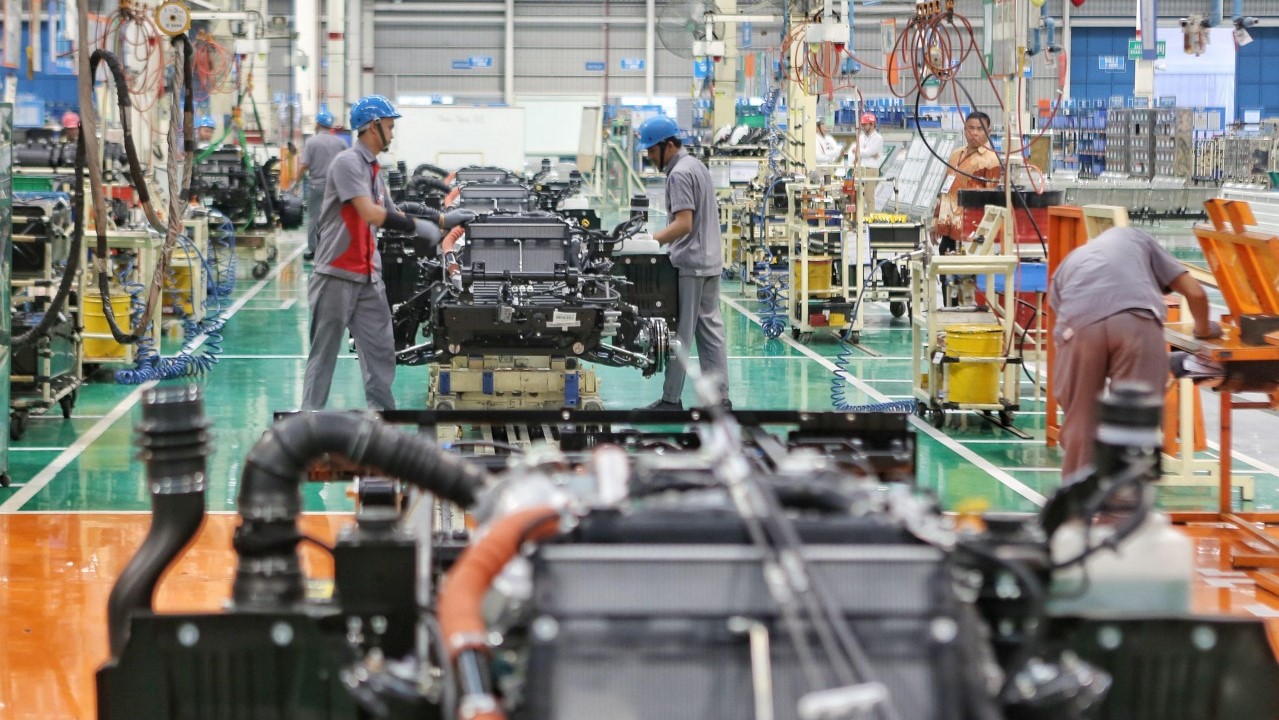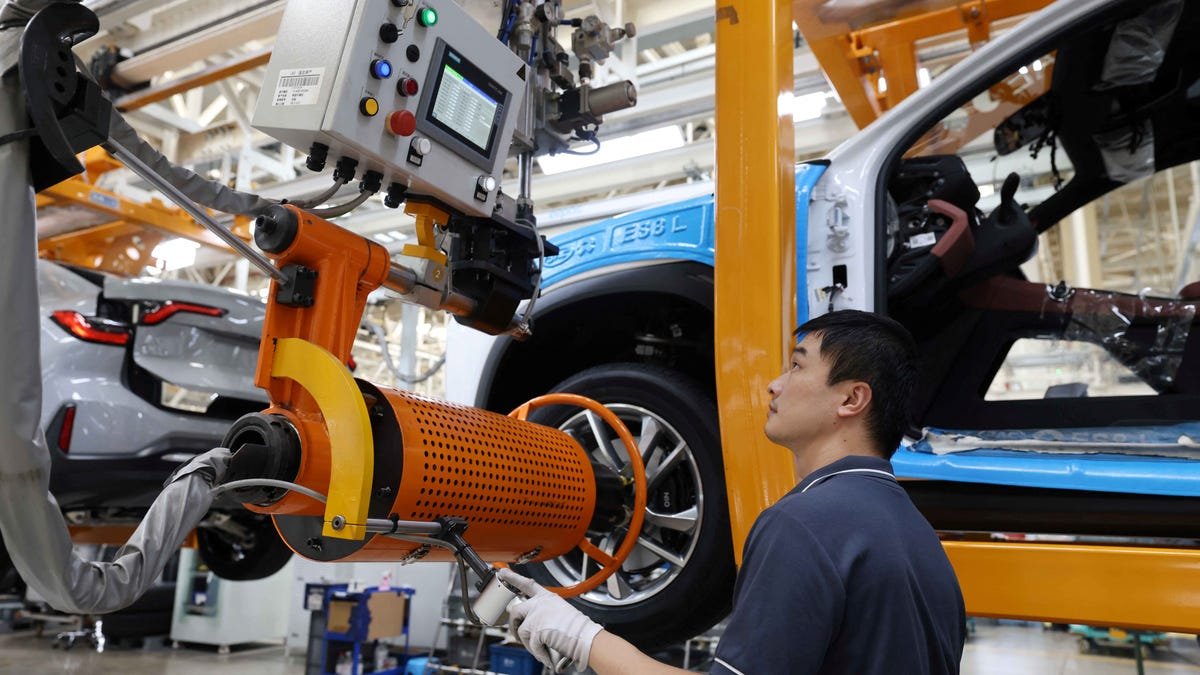Published 26 September 2023
The US remains at least indirectly dependent on Chinese supply chains despite what headline trade figures might suggest. Vietnam and Mexico have emerged as major destinations for an ongoing supply chain reconfiguration, but the changes, at least for now, may be more cosmetic than real.
Supply chains are moving out of China, with Vietnam and Mexico emerging as key replacement destinations. The Sino-US geopolitical contest and US sanctions and tariffs are crucial factors driving global businesses, including Chinese ones, to move their manufacturing to locations the US designates as “friendly”.1
Recent studies have shown US purchases of Mexican and Vietnamese goods across 2017-2022 correlate strongly with a declining Chinese share of US imports. Concurrently, the US is investing less in China and more in Mexico and Vietnam.
However, this is not a straightforward displacement of China. Both Vietnam and Mexico are receiving more Chinese imports of and investment in intermediate goods than ever before.
Rather than undergoing a wholesale shift, supply chains are reconfiguring around trade barriers and new political exigencies. The results, analysts say, are often simply a rerouting of Chinese manufactured componentry to Mexico, Vietnam, and other economies such as India, where it is assembled and reexported.
China’s central position in global manufacturing means that indirect linkages to American supply chains will likely persist.
For all the Biden administration’s talk of a victory in reshuffling supply chains and Beijing’s efforts to increase domestic consumption, China’s trade ties to US consumers – who federal analyses show largely bear the cost of the reshuffle2 – have not been eroded.
Even if its exact form evolves, entrenched Sino-US interdependence will ultimately be difficult to unpick.
Trade war meets friend-shoring
China’s appeal as an export-orientated manufacturing base has been declining, especially for the most wage-sensitive industries. By early 2021, the number of foreign manufacturing companies in China had declined 24% from the 2014 peak to 43,700.3
China has long since passed the point where its primary advantage is cheap labor. As the economist Michael Pettis has argued, China’s competitiveness lies more in its costs relative to productivity, rather than absolute cost base.4 A proliferation of direct and indirect subsidies has sustained this relative advantage for industries higher up the value chain.
The upshot is that additional incentives or indeed disincentives are going to be required to engender a more radical shift in the composition of US supply chains. Former President Trump’s imposition in 2018 of tariffs on Chinese exports epitomized the trend. Tariffs were progressively expanded to cover almost all Chinese exports.
Still, some firms were initially on the fence about moving production out of China. However, the exogenous shock to US supply chains caused by COVID-19 further shifted the dial towards a more interventionist economic policy to re-shore US production.
President Biden has ignored calls for Trump’s tariffs to be rescinded. The revival of US industrial policy, coupled with persistent exhortations for US business to “friend-shore”, the Biden administration’s moniker for the policy to push corporate relocation to “friendly” nations, has put to bed any doubts about the prevailing tenor of US economic policy.
Supply chain reconfiguration in motion
There has been an abundance of data-based evidence on the relocation of supply chains out of China to evade US sanctions and tariffs from 2018 onwards.
Though global trade has continued to grow in value, in part in recent years due to inflationary commodity prices, China’s share of US imports peaked at 21.6% in 2017, dropping to 16.7% by 2022, and to just 14.6% in the 12 months to July 2023.5
China’s apparent “loss” has been Vietnam and Mexico’s gain. Across 2017-2022, Vietnam increased its US import market share from 2% to 4%. From 2017 to July 2023, Mexico’s exports grew 1 percentage point off an already high base to 15%, making it the largest source of US imports.6 Mexico’s manufacturing exports to the US have boomed, growing 26% from US$320 billion to US$402 billion across 2020-2022. The US now absorbs around a quarter of Vietnamese exports.
The more granular aspects of an August 2023 study by Harvard Business School’s Laura Alfaro and Dartmouth College’s Tuck School’s Davin Chor show how imports from Mexico and Vietnam directly displaced Chinese exports. China recorded decreases of between 0.2 and 0.7 percentage points for US-bound exports of footwear, apparel, and electronic goods like monitors and printers.7
Concurrently, US-bound Mexican exports of electronic goods increased markedly. Vietnam has seen conspicuous spikes in shipments of apparel, footwear, and light electronics. Mexican exports of furniture, steel, glass, and automobile parts have also won out over Chinese competitors.
Changing foreign direct investment (FDI) patterns have been integral to facilitating the redirection of trade flows. After peaking in the early 2010s at nearly US$230 billion, greenfield US FDI into China has been in secular decline since 2017-18.
Mexico’s proximity and enmeshed free trade links makes it a particularly attractive investment destination to feed the US market. US FDI into Mexico’s automobile and electronics sectors has most conspicuously taken share from falling FDI into China.8 In 2021, US companies invested more in Mexico than in China.9 This year, Tesla is moving ahead to build a US$5 billion Gigafactory, which typically make electric vehicles ad clean tech products, in the Mexican city of Monterrey.
Conversely, US FDI into Vietnam has risen less perceptibly. Geography and the absence of a free trade agreement are two obvious inhibiting factors. This may soon change. Biden’s recent visit to Vietnam showcased Washington’s clear intent to transform Vietnam into a US hub for semiconductors and rare earths production.10
China Inc. adapts to new geoeconomic realities
At first glance, the diversion of FDI and imports away from China toward Mexico and Vietnam looks like de-risking par excellence.
The reality is more nuanced. To circumvent US trade barriers, Chinese companies are ratcheting up trade and FDI links with third-party countries.
Chinese companies are reprising a variant of a strategy previously used by Japan. By the 1980s, Japan’s persistent trade surplus was firmly in Washington’s crosshairs. To mollify trade frictions, Japan substituted direct exports by shifting production to the US and re-routing exports of mostly intermediate goods through South Korea and Taiwan where final assembly occurred.11
Growing US skepticism over accepting Chinese investment means that it will be difficult for China to move production to the US. Instead, China has bolstered exports of intermediate goods to Vietnam and Mexico and built factories in both countries.
China’s share of Vietnam’s imports has risen from 26% in 2010 to over 40% in 2022. Mexico has seen a 5-percentage point increase in Chinese imports from 15% in 2010 to 20% by 2022.12 Many of these Chinese exports clearly feed into US supply chains. In Vietnam’s case, its top imports from China are integrated circuits, textiles, and office telephones – all inputs in goods categories where China-based exporters have lost US market share.
Official data on Chinese FDI in Vietnam and Mexico is patchy. Nonetheless, it is still possible to discern an upward trend. According to official Vietnamese statistics, Chinese projects accounted for around 8% of Vietnam’s inbound investment in 2021, compared with 2% share from the US.13
Vietnam’s proximity to China facilitates its easy integration into Chinese supply chains. This has made it especially attractive to suppliers to multinational giants such as Apple looking to support the companies’ diversification push. Top Chinese Apple suppliers including Luxshare Precision Industry, GoerTek, and BOE Technology Group, have all set up shop in Vietnam.14 Vietnam mostly remains an assembly hub, with Chinese suppliers undertaking higher value-adding activities north of the border.
Chinese investment in Mexico – mostly in the automobile and electronics sectors – reached US$151 million in 2022 on official figures. This is probably a gross underestimate. In its 2022 Reshoring Index, the management consultancy Kearney notes that “shelter companies in the US and Mexico” are masking the ultimate origin of invested capital.15 Industrial parks in border cities like Tijuana, Juarez, and Monterrey are full to the brim with Chinese manufacturers and their suppliers.16
Chinese investment in both countries has been of varying benefit to local economies. Apple suppliers’ investments in Vietnam are probably higher up the quality spectrum, providing mass employment for lower-skilled workers.
The endurance of US-China interdependence
US dependence on China is evidently difficult to shake.
The US is now Vietnam’s top export market and by far Mexico’s largest. Yet, any geopolitical advantages accruing to Washington are likely offset by the crucial facilitatory role that Chinese imports and capital have played in this trade reorientation.
Nor is this supply chain pivot without cost to the US consumer. Economists estimate a 10% increase in Vietnam’s unit price of imports associated with a 5% decrease in China’s share of the US market. This raises the question of how sustainable Vietnam and Mexico will be as “friend-shoring” locations, given already sharply rising production costs.
Just as Korea and Taiwan did in the past, Mexico and Vietnam will ultimately need to develop greater indigenous value-adding capacity to guarantee competitiveness. From the US viewpoint, this would have the added benefit of more meaningfully reducing reliance on China.
It would be remiss to focus only on US dependences. The obverse of this dynamic is China’s enduring reliance on the US consumer market. Combined with the EU market, this market continues to be the sun around which global value chains (GVCs) revolve.17
China’s reliance on trading partners that are US geopolitical allies is rising. Recent data on Taiwan’s exports to China – which accounts for 40% of Taiwan’s exports – is illuminating. A study by Jason Kao estimates that up to 90% of Taiwan’s exports to China are ultimately consumed elsewhere after processing in China, with the US being the primary destination.18 A similar dynamic is at play with Korea’s semiconductor exports to China.19
On the export side of the ledger, the total value of Chinese merchandise shipments to Southeast Asia have recently declined precipitously as Western consumer demand wanes. This belies overly optimistic depictions of the region as a rival alternative export market. Rather than being consumed in Southeast Asia, many intermediate and finished Chinese goods are now being processed or assembled in the region before re-export to Western markets.20
Until Beijing makes good on its rhetoric of boosting domestic consumption, the US market will be crucial to absorbing China’s overcapacity – whether this is in the form of direct exports or production intermediated by third parties.
This is not to say that the US strategy is without consequence to the Chinese economy. A 2021 study showed a 2.5% average decline in per capita income in industrial areas of China subject to US tariffs.21
More recently, there has been a plethora of anecdotal reports of Chinese labor hirers experiencing unusually quiet conditions as production migrates from China.22 Though this will theoretically free up workers for China’s priority industries like electric vehicles, there is a limit to how many lower-skilled workers these higher-tech industries can realistically absorb.
Conclusion
Even if there is a growing trend of trade being motivated by political rather than strictly economic factors, the fundamental reality of US-China interdependence remains. This is true even if Sino-US trade is increasingly being mediated by third parties, imposing costs and inefficiencies for both sides.
Global businesses have made expensive bets on shifting production out of China. These early movers will be counting on Washington to maintain policy continuity and refrain from seeking to unscramble the egg.
***
[1] Alfaro & Chor, “Global Supply Chains: The Looming “Great Reallocation”, National Bureau of Economic Research.
[2] US International Trade Commission ‘Economist Impact of Section 232 and 301 Tariffs on US Industries’.
[3] Kawakami, “Shenzhen tamps down wages”, Nikkei Asia.
[4] Pettis, “The Only Five Paths China’s Economy can follow”, Carnegie Endowment.
[5] Averbuch & Alvim, “Mexico’s Moment: the Biggest US Trading Partner is no longer China”, Bloomberg.
[6] Ibid.
[7] Alfaro & Chor, Op. cit., p.14-18.
[8] Alfaro & Chor, Op. cit., p.20-25.
[9] Goodman, “’Ok, Mexico, Save Me’”, New York Times.
[10] Vietnam-US Joint Leaders Statement, White House.
[11] Alfaro & Chor, Op. cit., p. 32-33.
[12] Alfaro & Chor, Op. cit., p. 27.
[13] Alfaro & Chor, Op. cit., p. 29.
[14] Barnes, Apple’s Factories in Vietnam”, Vietnam Briefing.
[15] 2022 Reshoring Index, Kearney.
[16] Ibid.
[17] Meszaros, “A ‘protectionist’ United States still key to East Asia’s economy”, East Asia Forum.
[18] Fitzgerald, “Why Japan and South Korea care about Taiwan”, ASPI.
[19] Davies, “South Korea pivots from China to US, Financial Times.
[20] Rongqian & Wei, “Weakening Trade Pushes Down Shipping Rates”, Caixin.
[21] David & Wei, “Who won the US-China Trade War, Wall Street Journal.
[22] Li & Ting-Fang, “Tech suppliers skip seasonal hiring rush”, Nikkei Asia.
© The Hinrich Foundation. See our website Terms and conditions for our copyright and reprint policy. All statements of fact and the views, conclusions and recommendations expressed in this publication are the sole responsibility of the author(s).








